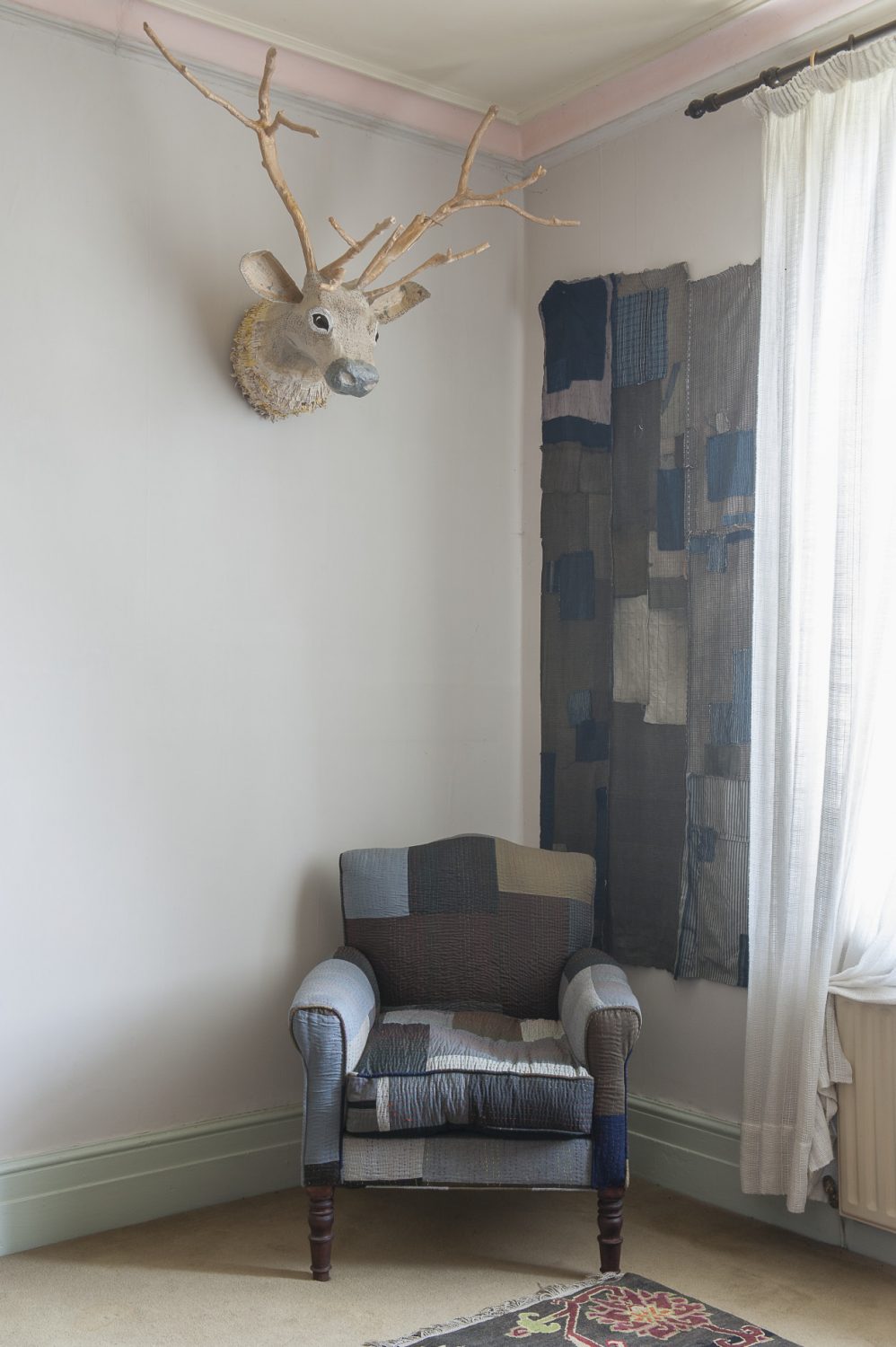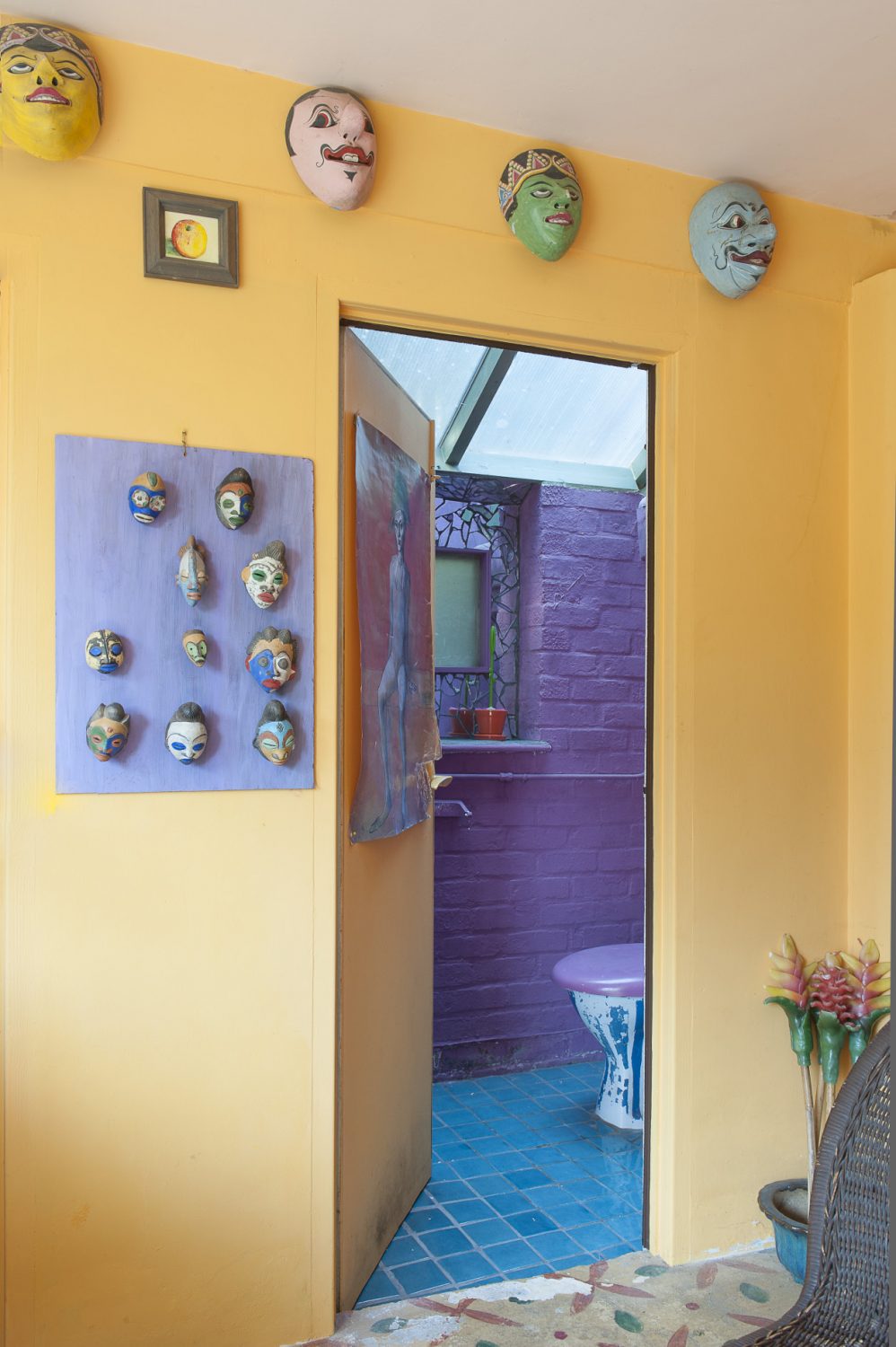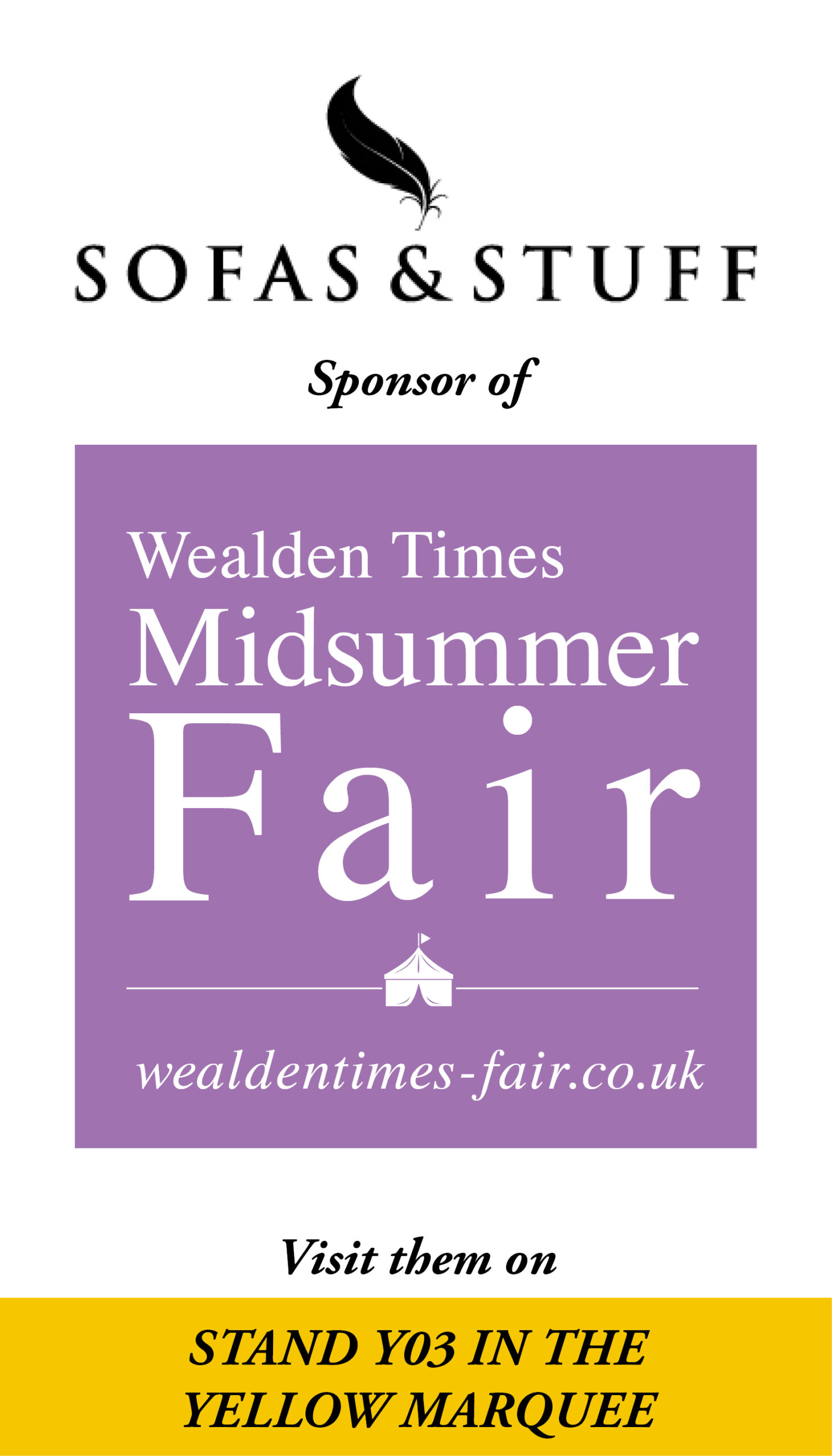Without doubt, a visit to the Hastings home of internationally renowned contemporary craft artist Kaffe Fassett and his partner and studio manager Brandon Mably, would bring joy to even the most downhearted of people. Filled with an explosion of colours and textures, each room in the early Victorian property invites the visitor to explore, what is in effect, a living showcase of Kaffe’s and Brandon’s work.
Best known for his colourful designs in the decorative arts – fabric, knitting, needlepoint, patchwork, painting and mosaic – Kaffe was born in San Francisco. At the age of 19 he won a scholarship to the Museum of Fine Arts School in Boston, but left after three months to paint in London and has stayed ever since.
Brandon, a celebrated designer in his own right, particularly for his amazing skill at combining colours, met Kaffe in the late 80s and soon realised the creative potential of knitwear designs. He runs the Kaffe Fassett Studio as well as holding knitting, needlepoint and patchwork workshops around the world.
“We originally had a little place in Rye,” explains Kaffe in his soft Californian accent, as we settle down to chat in the beautiful sunlit living room, “but it really was quite small. Hastings had been my first choice when we were thinking about moving because I love colour and I just love its terraces painted in different seaside colours.
“We came over to look around, and after about 16 awful, depressingly dark places, we suddenly saw this advertised. It had five bedrooms and the name of the road was the middle name of my good friend Bill Gibb (the late iconic fashion designer) and the house had the same name as my sister, so I thought, this is too much – we’ve got to go and look at it. Brandon and I rushed over here, walked up the drive, opened the front door and I said to myself, ‘this is it’. We walked into the living room, which had a white marble fireplace, the sunlight was streaming across the floorboards and it was a done deal.
“We moved in on the day of 9/11,” continues Kaffe. “Brandon went out to a fish shed to buy some fish for lunch and in the back of the place the man said: ‘Come and have a look at this on the television’. Brandon called me up and said: ‘Quick, plug in the television.’ And of course I watched the whole thing unfold. So we’ll never forget the day we moved in.”
Kaffe and Brandon share the house with Brandon’s mother Yvonne and his sister Belinda who also both share a passion for creative knitting. They look after the house when Kaffe and Brandon are staying at their London home in Kilburn or when they are travelling around the country and world with their work. When we arrive, Yvonne and Belinda are out walking with the final member of the family – Fudge the Jack Russell/whippet cross.
Hidden in a tranquil oasis off a busy road, the lavender blue villa built in 1840, was originally constructed as two properties, with the living room once part of a dance studio. Wonderfully proportioned, each room is blessed with high ceilings and a variety of large, different shaped windows, all of which let in an enormous amount of light. “Light is incredibly important to me,” says Kaffe. “As an artist I need it to do my work and to paint. I always have projects on the go – I have a knitting project with me this time and I usually have a big needlepoint carpet or something that I am working on, so there is always plenty to do.”
The evidence of this is clear to see throughout the house. The living room alone is filled with countless examples of Kaffe’s work, set against the most enchanting mural, which fills the entire end wall. A pile of knitting in scrumptious shades of plum and purple nestles on a small table next to the sofa, which in turn is covered by one of Kaffe’s beautiful quilts. A plethora of needlepoint cushions with images of lilies, hibiscus and peonies, all worked by Kaffe, are scattered along the sofa and adjacent chaise longue. Other quilts and knitted blankets are draped effortlessly over chairs and, during the day, the television, giving the whole sun-drenched room a comforting but quite spectacular appearance. A vibrant painting by Kaffe of ceramic vases hangs above the sofa perfectly complementing the textile work below.
“When we moved in, this room had two murals,” explains Kaffe, “one on the fireplace wall which we covered over and one on the end wall. I decided the room should be painted in very soft, pearly seaside colours so we got a lovely golden hue for the ceiling and soft shell pink and lavender pinks for the walls. I love shades of pink together.”
Kaffe then got to work on the end wall mural. “When I first painted it, the colours were quite strong and then I softened it as I thought it was taking over the room. It’s very satisfying just to put glazes on it so it appears to be in a pearly mist.” Did he have anywhere particular in mind when he painted it? “Oh, it’s a snatch of this and a snatch of that,” he laughs. “It reminds me of old Victorian wallpapers and I’m sure there’s a touch of the Punjab in there somewhere!”
The huge, floor-to-ceiling sash windows at the mural end of the room look out onto the gently sloping enclosed garden, which includes a raised patio area. “I made the pelmet and in fact there is one set of curtains behind the other,” explains Kaffe, as he separates the two sets of material. “The bottom set is made from handkerchiefs and cotton squares of fabric which was really fun to do.”
Turning to the other end of the room, the original fireplace is now home to a wood-burning stove above which sits a huge ornate mirror. Reflected in the mirror and hanging on the opposite wall, is a simply stunning needlepoint carpet called Cabbages and Apples. Originally done by Kaffe for a book, the piece used to be available as a kit from the Erhman Tapestry catalogue for which Kaffe is still a principle designer.
Two of the four easy chairs in the room have been upholstered in needlepoint by Kaffe, continuing the floral theme. These blend perfectly with the honey-coloured floorboards which were here when Kaffe and Brandon moved in. “We were so lucky,” acknowledges Kaffe.
Moving across the hall into the dining room is akin to entering an Oriental garden. With the original idea to cover the walls in hand painted Chinese wallpaper jettisoned due to the cost, Kaffe once again picked up his brushes and set to work. “I just painted straight over the original paper with Duck Egg Blue and started painting bamboo and peonies, and a friend of mind painted the birds,” he says quite matter-of-factly.
The same approach was taken with the dining chairs which each received either a coat of pale blue or lime green. The seats are again upholstered by Kaffe in large needlepoint flowers.
Sitting on the sill of just one of the unusually shaped windows to be found throughout the house, is a row of upturned Chinese bowls and a bust of an exotic looking woman. The latter was collected by Brandon who has a particular interest in sculpture.
Hanging over the dining table, which is covered by one of Kaffe’s classic patchwork fabrics called Rose Leaf, is the most enchanting flower chandelier. “We got this made in Venice,” recalls Kaffe (the glass flowers come out of their hoIders). “We wanted a pastel antique chandelier and we just couldn’t find one. They were all in hard, dark colours. I explained to the man in this particular glass shop we were in that I just couldn’t find the colours I wanted. And he said, ‘Well what colours do you like?’ and he just went around the shop asking me if I liked this flower or that flower until he had a big bunch and then said: ‘We’ll make you a chandelier.’ The piece still included one or two dark colours but I’ve painted over them with acrylic paint to make them look like they’re old pastel ones.”
The two leafy grapevine candelabra seemingly ‘growing’ from the mantelpiece were found in a local antique shop. Originally dark bronze, yes, you’ve guessed it, they received a Kaffe makeover and are now a gorgeous verdigris hue complete with plump lilac grapes.
Kaffe’s hands-on approach to interior design is never more apparent than in the kitchen. We sit at an old oak table surrounded by a variety of different wooden chairs, all sourced from local antique or junk shops. The walls and tall built-in cupboards are painted in vibrant shades of lime green accentuated by an intricate orange and red rug which sits under the table.
Fixed around the archway in the middle of the kitchen, wire baskets from South Africa add swirls of colour and pattern. “When I see something unusual and beautifully individual I just grab it, because those things are few and far between,” says Kaffe. “And then I come home with them and think ‘where will they go?’ I don’t plan anything. My life is very organic.”
One of Kaffe’s bigger interior projects were the blue and white tiles that cover the kitchen walls, which he designed and painted himself at Highland Stoneware in Lochinver, Sutherland. It takes some time to look at the dozens of intricate designs, many of which include animals, flowers and jars of preserves. “Boy was that a lot of work,” laughs Kaffe. “There are about 500 tiles and it took five or six trips up there to complete the whole project.
“When we finished the tiles in the kitchen, we suddenly thought: ‘What are we going to do about the floor? It was a horrible grey concrete so I just took four shades of paint, mixed them up and painted big tumbling blocks in earthy fresco shades in one night. By the time we came down in the morning it was dry and ready to use.”
If our senses weren’t already on a Technicolor high, they were given an additional shot as a profusion of orange, purple, turquoise and every shade in between greets us as we enter the garden room. “It’s kind of crazy, isn’t it?” says Kaffe with some degree of understatement. The purest turquoise tiles cover the downstairs loo floor and are offset by stunning purple brick walls and a mosaic mirror. The orange walls of the garden room are decorated with masks from Bali and a shell mirror made by Kaffe for the 1998 Chelsea Flower Show where he designed a garden for Hilliers Garden Centres.
Shelves of books including many written by Kaffe and Brandon themselves, sit next to rows of coloured yarns stacked in contrasting but complementary colours. “That’s very nicely done, isn’t it,” notices Kaffe as he passes by. “I hadn’t stopped to look before.”
Moving upstairs, the bedrooms and bathroom are on two levels, with four bedrooms on the middle floor and the bathroom and remaining bedroom at the top of the house. In the first room we come to, one of the two single beds is overlaid with a quilt made by prisoners through the charity Fine Cell Work of which Kaffe is a patron. Fine Cell Work is a social enterprise that trains prisoners in paid, skilled, creative needlework undertaken in the long hours spent in their cells.
The next room, painted in shades of purple with red drapes, is once again a kaleidoscope of colour. A huge needlepoint rug entitled ‘Shells and Tortoise’ and once again designed for the Erhman Tapestry kit range, rests on the back of a sofa which in turn is covered by a bold geometric patterned patchwork rug. In front of the sofa is a smaller flower rug on top of which, acting as a small table, is an olive green suitcase. A wooden turned bowl filled with balls of coloured wool perfectly blends with the surrounding furnishings. On the right of the sofa hangs an antique Chinese robe above a mound of colourful scatter cushions. Turn your eyes to the left and you see an ochre mantelpiece above a painted blue fire surround adding yet more colour to the room.
Brandon’s room opposite, however, is a rather more muted interior, bringing with it a sense of calm and serenity. Pastel blue walls accentuated with pale pink coving are the perfect backdrop to some quite remarkable pieces of work. Hanging over the bed is a quilt given to Kaffe by a German quilt guild made from remnants of the suits worn by men in Auschwitz. In sharp contrast to this incredibly sensitive piece is the profusion of colour exuded by the quilt covering the bed which was created by Brandon using his own fabric designs. And a final accent of colour belongs to a gorgeous needlepoint lips cushion, a gift to Kaffe and Brandon from leading designer Candace Bahouth.
Opposite the bed is a chair from HomeSense with a cover made of scrap pieces of cloth in shades of blue, grey and brown, loosely stitched together. Brandon bought the chair as it worked so well with an existing Japanese textile wall hanging that is suspended by the window.
Amongst the many treasures to be found in this room, two really stand out – a magnificent papier mâché stag head bought from an artist in Lewes and a giant Chinese egg standing in the fireplace, discovered in an antiques shop in Hastings Old Town.
As you climb the stairs to the top floor of the house, you are met by an arched window inlaid with blue and red panels, giving a rich stained glass effect. Turning to the left you pass through a sandy coloured hallway with pale blue accents on the wooden surrounds echoing the nearby beach. On entering the bathroom you suddenly arrive at the seaside. Floor tiles in muted earthy tones complement the small square pastel wall tiles that run behind the freestanding bath and basin. “The original tiles in the bathroom went everywhere and were very set in their style,” explains Kaffe. “I wanted these soft sandy colours with different textures so we went to every tile place in the area and picked up box after box and now we have a bathroom tiled in beautiful seaside colours.” An ornate, vintage mirrored pine washstand found in Butler’s Emporium on George Street in Hastings Old Town, adds to the relaxed coastal ambience.
As we make our way downstairs, Yvonne and Belinda are back and busy in the kitchen unpacking fresh produce bought from a local farm shop and fishmonger. Fudge is in his basket catching up on some well-earned sleep after his walk and Brandon is in the garden working on one of his projects. “We are a very relaxed house,” laughs Kaffe as he lowers himself into a chair next to Brandon to take in the late afternoon Sussex sunshine.
TEST
Kaffe and Brandon had originally intended to paper the dining room with hand painted Chinese wallpaper, but Kaffe painted straight over the original paper with Duck Egg Blue and an intricate design of bamboo and peonies
TEST
Hanging over the dining table, which is covered by one of Kaffe’s classic patchwork fabrics called Rose Leaf, is the most enchanting flower chandelier
TEST
The 500 blue and white tiles that cover the kitchen walls were hand-painted by Kaffe at Highland Stoneware in Lochinver, Sutherland. Kaffe covered the original grey concrete floor in big tumbling blocks in one evening
TEST
In the seating area of the kitchen, the walls are painted in vibrant shades of lime green accentuated by an intricate orange and red rug which sits under the table
TEST
A plethora of needlepoint cushions with images of lilies, hibiscus and peonies, all worked by Kaffe, are scattered along the sofa and adjacent chaise longue
TEST
Kaffe’s ‘Cabbages and Apples’ needlepoint is perfectly reflected in an ornate gilded mirror above the white marble fireplace
TEST
Two of the four easy chairs in the sitting room have been upholstered in needlepoint by Kaffe, continuing the floral theme. These blend perfectly with the honey-coloured floorboards which were here when Kaffe and Brandon moved in
TEST
In the bathroom, floor tiles in muted earthy tones complement the small square pastel wall tiles that run behind the freestanding bath and basin
TEST
The upstairs sitting room is painted in a vibrant shade of purple. A huge needlepoint rug entitled ‘Shells and Tortoise’ designed for the Erhman Tapestry kit range, rests on the back of a sofa which in turn is covered by a bold geometric patterned patchwork rug
TEST
In front of the sofa is an olive green suitcase which acts as a table. The wooden turned bowl on top is filled with balls of coloured wool which perfectly blend with the surrounding furnishings
TEST
On the right of the sofa hangs an antique Chinese robe above a mound of colourful scatter cushions. An ochre mantelpiece above a painted blue fire surround adds yet more colour to the room
TEST
Across the hall and opposite the purple room, Brandon’s room is a rather more muted interior, bringing with it a sense of calm and serenity
TEST
Hanging over the bed is a quilt given to Kaffe by a German quilt guild made from remnants of the suits worn by men in Auschwitz. In sharp contrast to this incredibly sensitive piece is the profusion of colour exuded by the quilt covering the bed which was created by Brandon using his own fabric designs
TEST
Brandon’s room is filled with a mix of contemporary and antique textiles from an old upholstered screen to a neon ship kite which was bought in Thailand
TEST
Opposite the bed is a chair from HomeSense with a cover made of scrap pieces of cloth bought by Brandon as it worked so well with an existing Japanese textile wall hanging that is suspended by the window. A magnificent papier mâché stag head bought from an artist in Lewes is mounted high on one wall
TEST
Behind a door in the vibrant garden room is the downstairs loo, painted a stunning purple and featuring a mosaic mirror. The orange walls are decorated with masks from Bali and South Africa
TEST
Coloured yarns are stacked in one corner in contrasting but complementary colours
TEST







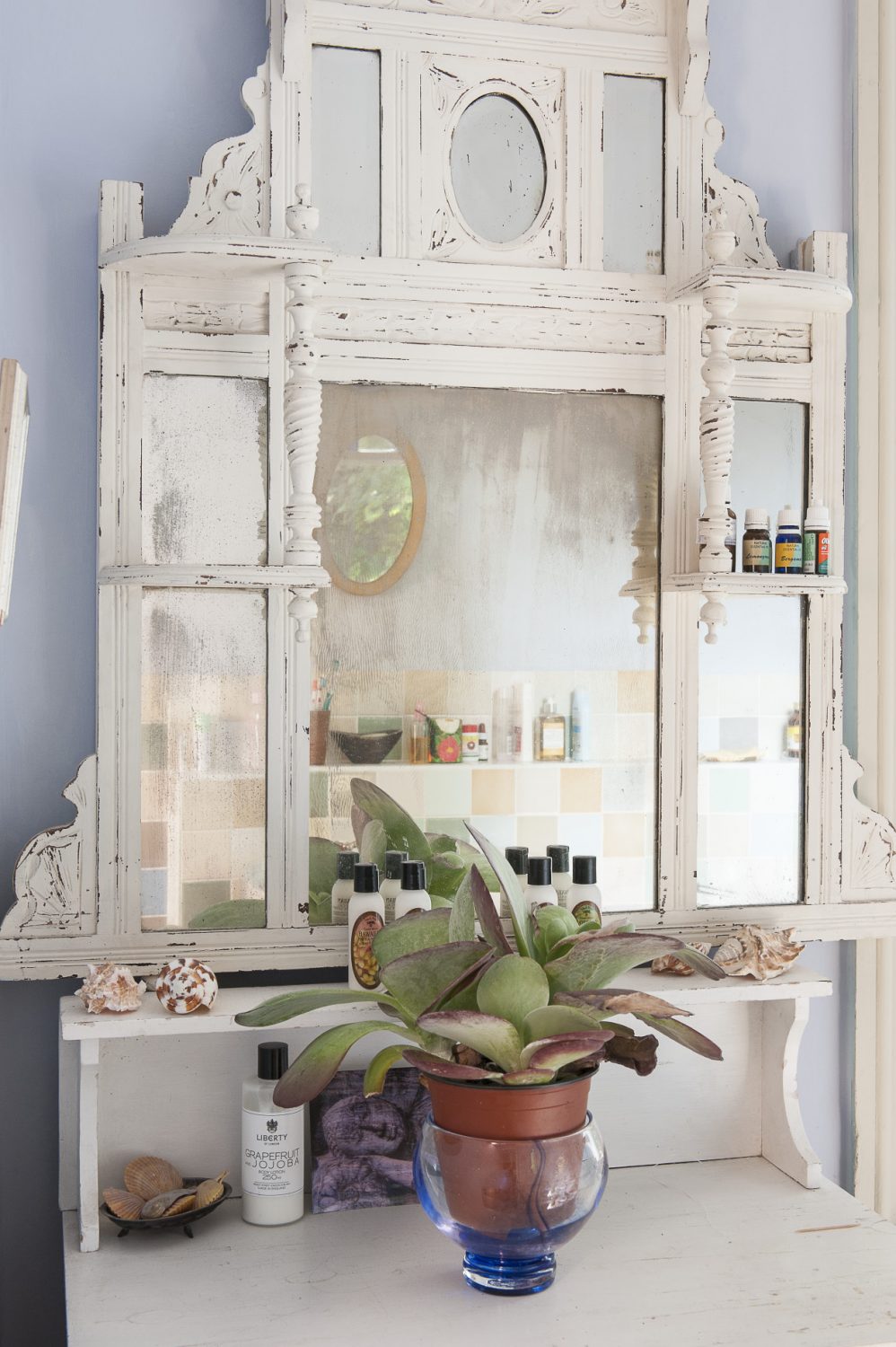 TEST
TEST

 TEST
TEST



 TEST
TEST

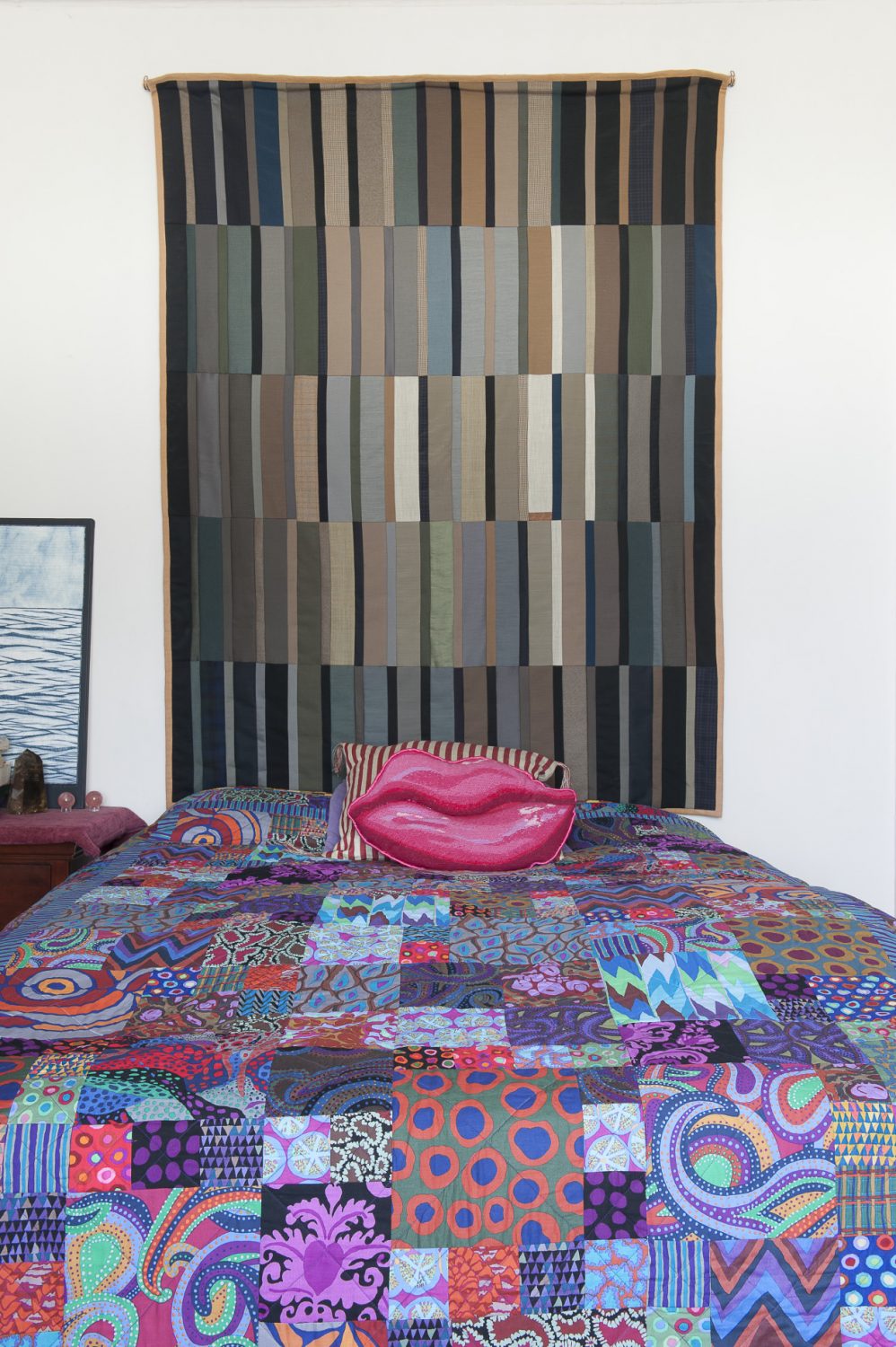
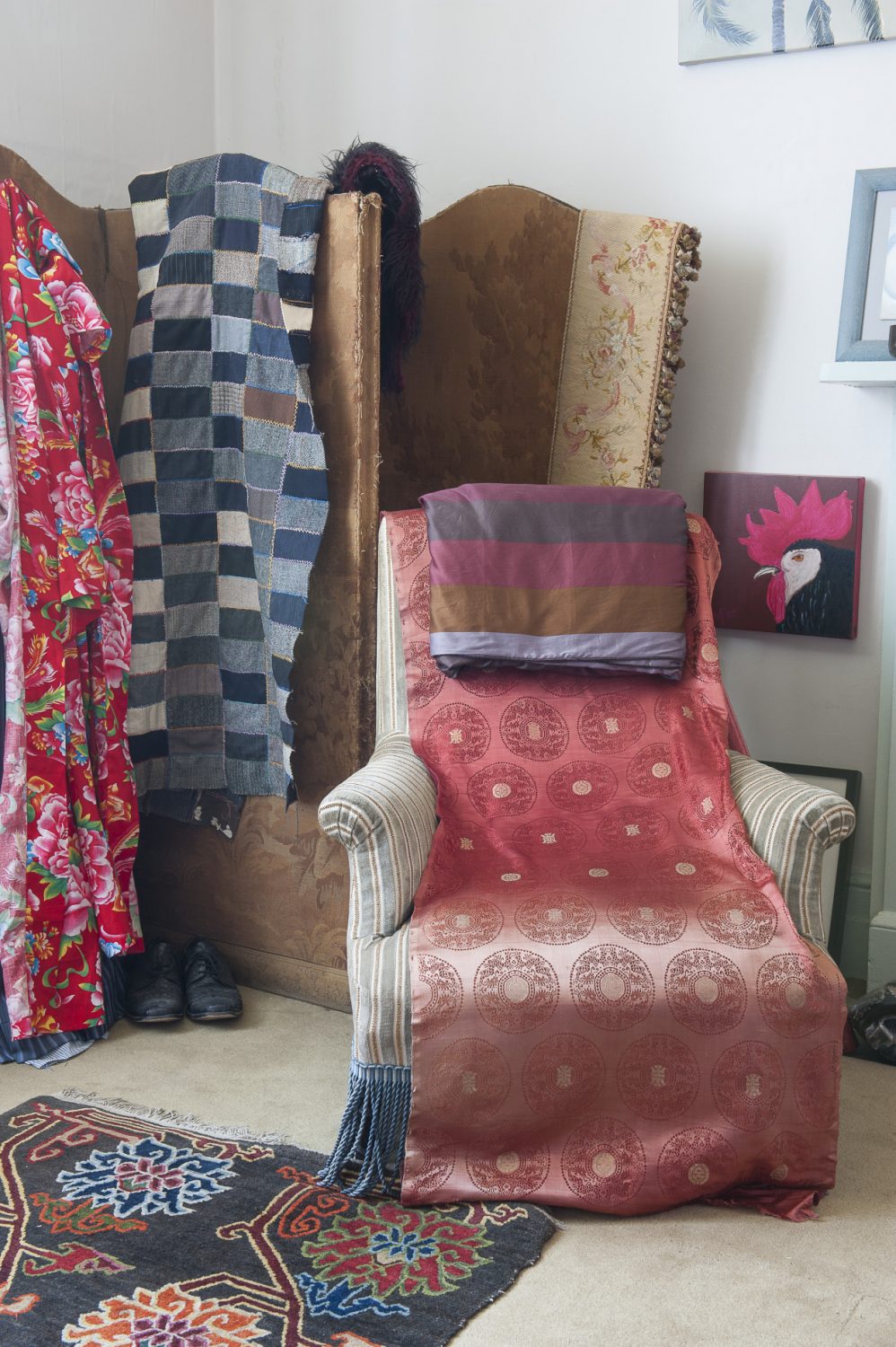
 TEST
TEST
